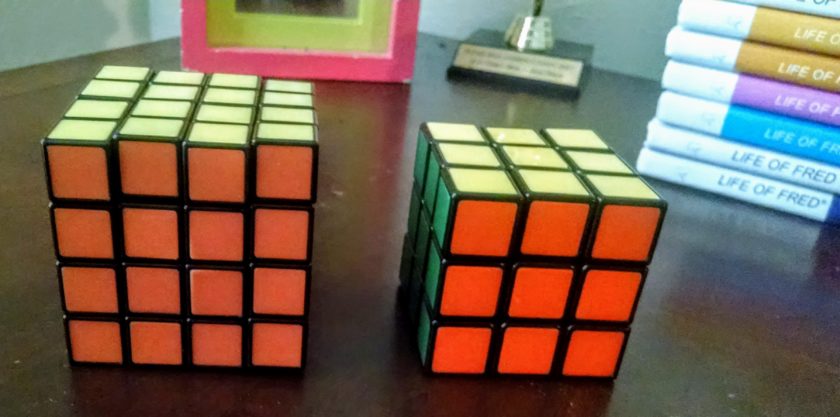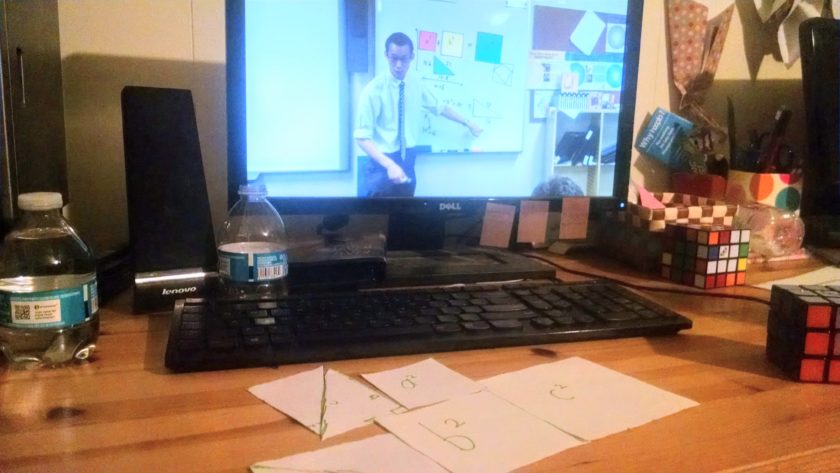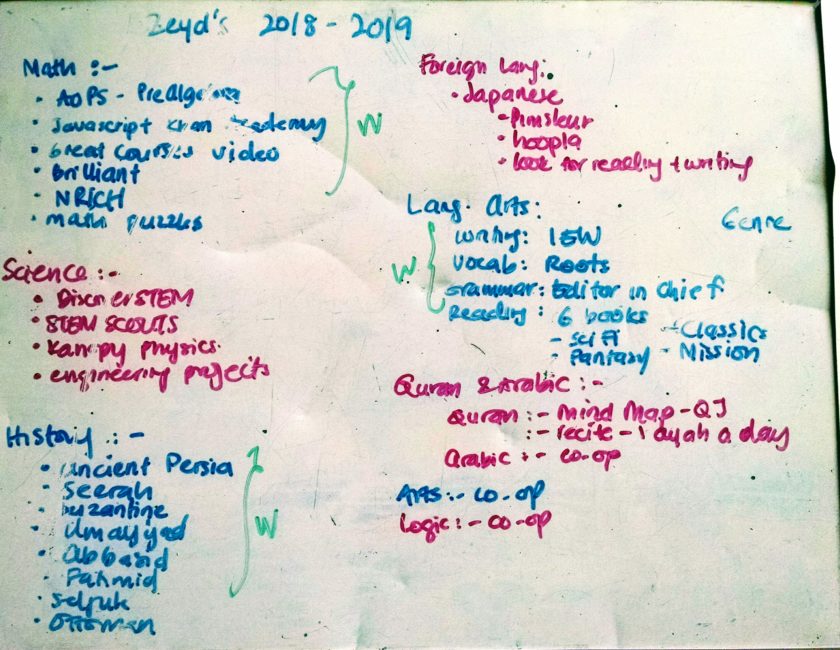I have had this task on my mental to-do list for the longest time. Alhamdulillah I finally was able to execute it a few days ago; discuss my 11-year old son’s homeschool plan for the upcoming school year with him. I strongly believe in having the child involved in homeschool planning. Of course, it’s obviously the parent’s judgment call to decide how and to what extent the child should be involved, but because of the flexibility homeschooling affords, this can be feasibly done.
Ownership
When we hand over the reins to someone, we are implying that we trust this person with the responsibility that comes with having the reins in his hands. When we treat a child like a child, she will behave like one. But when we give her responsibilities, we are giving her the message that we trust her enough to give her those responsibilities. As a result, she may take more interest in the matter. Apply this to homeschooling and you are thus engaging a child in his education by giving him a say in what he wants to do, how he wants to do it, and what curriculum is a good fit for him.
Now, you might think that if we give the child this much say, he might not want to do anything but play video games! This is where the parent would use her or his judgment call. With my older kids, for one particular year, I decided to divide the year into four quarters and make it project-based, ending each quarter with presentations of their projects as I had mentioned here. I made the list of topics beforehand, and they had to choose from it or suggest other topics. They were required to research and come up with something to present at the end of the quarter. In a way, it was open-ended, but it also had objectives and structures embedded in it. That year, I noticed that they were more involved throughout the homeschool year, because they had the choice of what it was they wanted to delve into each quarter. Now, with my 11-year old, I researched the curricula beforehand, decided what we should be focusing on with some open options he can choose from, and picked methods/options that are feasible for us, and presented these to him for discussion.
What is truly happening is that they feel they have a say in it, but you are still in control. You are just giving them options. It’s akin to asking a preschooler,
“Do you want to put your toys away now or after your snack?”
The certainty is that she has to put her toys away, but she is given a choice as to now or after she has her snacks. Giving them a choice aids in having them cooperate, which is a boon in homeschooling!
Cooperation
When the child senses that the parent trusts her enough to ask for her opinion, she will be more willing to cooperate than if the parent dictates everything. It also makes the whole homeschooling journey a family’s journey. I have always practiced asking my children’s opinions in different matters, just to make them feel trusted and more responsible, as well as to give them a sense that their feelings and thoughts are important and valuable to me as well. Sometimes, I ask their opinions in mundane matters, even when I don’t really need their opinions. Nevertheless, this gives them a chance to express their thought process and logical reasoning as well as build their confidence in taking a side or seeing things from a different point of view. Now that my older kids are all adults, they are quite generous in giving me their opinions, some of which are unsolicited. Yet, in the throes of pre empty-nest syndrome, I decided that I still treasure these unsolicited opinions as deeply as when they were younger.
One thing I had really taken to heart from Adele Faber and Elaine Mazlish’s book How to Talk so Kids Will Listen and Listen so Kids Will Talk, is to problem solve with the children. Homeschool planning for the upcoming year is somewhat of a ‘problem’ in that you want to make sure it is in line with what the child needs, and also that the child will cooperate and not resist it. Foreseeing this, I told my 11-year old that we would sit and have a meeting about his homeschool plan for the upcoming year. It was summer, and it was a while before I could actually carry out this plan. So, in building up anticipation for this meeting, I struck up a verbal discussion with him.
“Z, so for next year, what would you like to do with your Japanese? You want to learn to speak it? I’ll be your partner if you do.”
To be honest, I don’t really want to but if he wants it, I guess that’s what I’m here for, unless I can outsource it. First, the sparkle came to his eyes. And as it has always been with this particular child of mine, his emotions surfaced and manifested themselves in his facial expression. No words. His facial expression said it all. That is the excitement for the upcoming homeschool year. What better way to continue the homeschooling journey than with some excitement and anticipation!
Observing Your Child
In order to do this however, we have to have observed our child enough. Fortunately, since we are homeschooling, we really do end up knowing their strengths and weaknesses inside out, as well as their habits, tendencies, and eccentricities. This serves us well in homeschool planning because we can cater it to their learning styles, areas of interests, and strengths and weaknesses.
My son spends his free time making up math problems, doing random math on scratch paper, watching Great Courses videos on the Joy of Math, chess, Sudoku, and learning how to solve the Rubik’s cube, both the 3×3 and 4×4, not to mention delightfully poring over math logic puzzles for hours on end.  If it’s not obvious to me that he really likes math, I must have been really oblivious or plain blind! He was using Math Mammoth last year. Initially he enjoyed it, as we also used it the year before. I really like the curriculum because it shows different strategies to problem solving and it employs teaching the students number sense. However, after a while, my son began to resist working on it. His usual complaint was, “It’s too much!” and “I already know it,” though I had to dig the latter out of him. If I hadn’t seen him spending his free time doing math and watching Youtube videos on Calculus and Pythagorean theorem, I would have concluded that he is struggling in math and would have based my math curriculum search on that.
If it’s not obvious to me that he really likes math, I must have been really oblivious or plain blind! He was using Math Mammoth last year. Initially he enjoyed it, as we also used it the year before. I really like the curriculum because it shows different strategies to problem solving and it employs teaching the students number sense. However, after a while, my son began to resist working on it. His usual complaint was, “It’s too much!” and “I already know it,” though I had to dig the latter out of him. If I hadn’t seen him spending his free time doing math and watching Youtube videos on Calculus and Pythagorean theorem, I would have concluded that he is struggling in math and would have based my math curriculum search on that. 
Instead, I looked for something more challenging and came across Art of Problem Solving. I also looked at other options and seeing that he enjoys Recreational Math, I also looked up math enrichment resources, and found Brilliant, NRICH, and decided to include coding as part of his Math.
As we discussed these options, I could see his face lighting up at,
“Z, you can watch the Great Courses videos and we will count that as math too, you can do the math puzzles from those books, you can also do coding! Where are you at with coding now?”
“Javascript, with Khan Academy.” His voice was infused with excitement.
I also discussed the areas he’s resistant in.
“How about Quran? You like mind mapping, don’t you? You want to do mind maps of other surahs?”
He nodded, his eyes sparkling.
I added, “You still have to recite everyday, even if you don’t like to. How about we do this. You recite at least one ayah a day. On days that you really don’t feel like you want to, you just recite one ayah. Allah loves it when we do something consistently, even if it’s little. He loves it more if you recite just one ayah, but you recite it everyday, than if you recite a page one day and then nothing for a month and then two pages a day and then nothing for two months.”
He didn’t look too enthusiastic, but it was a compromise. At least, I’m getting his agreement on this, rather than suddenly putting up his daily schedule and demanding it of him with no discussions whatsoever.
His weak areas are reading and writing, and he knows it too. So for this, I said, “Z, we have to really work on reading, ok? What genre of books would you like to read?”
“Science fiction, like Wrinkle in Time.”
So, I listed the genres he picked, but I also added, “We’ll also try other genres okay? You get the genres that you pick and I can pick other genres too.” I was rewarded with a nod, albeit a delayed one. A nod nonetheless. I grabbed it.
I’m banking on all these to get his cooperation throughout the homeschool year. All those nods, even the reluctant ones, are part of him signing a contract that this is what we will do the upcoming year. He is old enough now to know that it’s important to discuss and come to some compromise when there are differences and most importantly, to follow up on the agreement and be a man of your words.
Getting It All Down in Writing
Of course, the actual meeting would require us both to sit down with pencil and paper. I used a small whiteboard and marker instead.We went through each subject. Since I had already done the research and thought the options through, I just discussed each option with him, and when he agrees, I wrote it down. For the suggested math curriculum Art of Problem Solving (AoPs), I showed him the curriculum and an excerpt from the PreAlgebra book and asked if he wants to use that curriculum for math instead of continuing with Math Mammoth. It actually took a bit of back and forth and yes and no, but we eventually settled on that, he will use AoPS as his math curriculum for this upcoming year.

He’s naturally curious and interested in history. So, for history, I asked him where we last were in our study of Ancient Persia, and listed what comes after, chronologically. In fact, he is so into history that while we were studying the beginnings of Ancient Persia, he had already been eyeing the Fatimid, Seljuk, Ottoman, etc in the battle videos he watches in his free time. So, when I was listing what we are going to continue with, I relied on him to tell me what comes before or after. He has been wanting to study the battles that happened in the Ottoman empire, which we encountered while we were studying Ancient Rome, but I kept telling him that we have to go in chronological order, so now, all that anticipation has accumulated.
Once I had everything down, and we both agreed on it, I entered everything into an excel sheet on my Google Drive, which is where I keep my homeschool documentation for all the kids.


This can look impressive or it can look pathetic. We might stick to some and even let go of others. However, it is important to have somewhat of a road map before we continue this journey in shaa Allah. At the very least, we have a plan. Most importantly, the process through which we did this, is as, if not more important, than the skills and knowledge he will gain from these subjects. By directly involving my son in this planning, I’m indirectly imparting to him that it is important to plan well, set goals, discuss and resolve differences, compromise, and document our agreement.
In the next part of this article series, I will expound on how to ‘skip middle school’ when planning for the upcoming homeschool year for a middle grade student.
Juli Herman is a homeschooling mother of four children, two of which are now in college. While pursuing her BSc. in Computer Science, she had her first two children. By the time she completed her final year, she was 100% certain of two things; stay home with her children, and rekindle her love of learning. As a bibliophile, Juli naturally instilled the love of reading to her children from a young age. Homeschooling became an obvious choice of education for her children as she read more about it. Through living a homeschooling lifestyle where love of learning is placed on a pedestal, she witnessed her children blossom into their respective areas of strength. Now that she has been homeschooling for over 19 years, she is glad she documented the journey on her homeschooling blog, which went through its own growth. Blogging has served as a great reminder of both the blessings and challenges of homeschooling to keep her going with the youngest child. Through it all, homeschooling has taught her a lot about the true meaning of tawakkul.
One Response